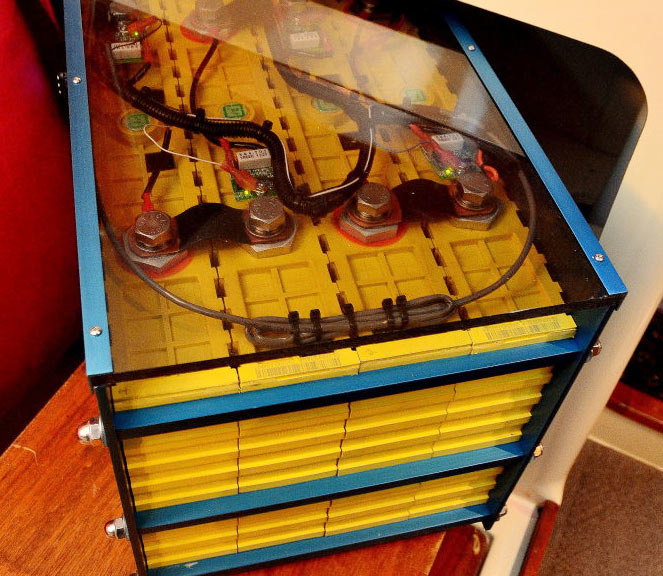(1) Does the brand/cost/type of Isolation Switch matter? If so, can you recommend one?
(2) One reply calculated for a 2200w inverter on 12v will have approx 2200 / 0.80 / 11.v = 240 Amps Max. @ 0.25v drop = 60w of cable heating.
This looks to be assuming a Max continuous inverter load of 2200w.
(3) If I kept heavy loads at approx 50% Max inverter rating (1100w) for very short time (2-5 mins of either microwave or hair dryer), will I avoid cable heating or BMS switch voltage drop issues?
(4)Does it help to shade any exposed cables (or cover for UV protection) & does it make sense to add passive ventilation to storage area where inverter is mounted (it has 2 built in fans if temp >104F or load > 880W).
(5)DC loads (directly from battery) will be...LED lights, water pump,slide out, phone charging, hitch jack, ceiling fan, portable fridge/freezer (3.8A).
These will be operating intermittently & since I don't know Amp draw for most, I will just have to keep an eye on the Battery Monitor & adjust usage accordingly.
#7 Ratings are for OUTPUT. A 1/2hp pump gives 1/2hp of pumping power, but it consumes MUCH more than 1/2hp of electricity (1/2 hp is about 375W). My 3/4hp (560W) water pump would overload my 2kW inverter due to the massive surge associated with the initial start of the pump motor. When it was running (from a bigger inverter), it consumes about 900W. A microwave is similar inefficient.
The microwaves are generated by the magnetron. When the circuit closes to allow the electron juice to flow, there is almost no resistance. Once current starts flowing through the magnetron, the magnetic field resists the incoming current until it reaches steady state. There are massive losses converting input electricity to water molecule excitation in the heated substance. You can get a better idea looking at the specs on your microwave or on the electrical label. They will publish a current. That current multiplied by 120VAC gives you the MAX power consumed. Here's an example for a 900W microwave:
In specifications, electrical:
Amperpage 15
Voltage 120
15 * 120 = 1900W - this accounts for the initial surge (sorta, it's actually much higher, but it last for only 1/60th of a second, it's not an issue for grid power, but it can be for an inverter). Once this surge passes, it will settle on about 1500W.
If you're in the habit of using lower power settings on your microwave, get out of that habit. Standard microwaves only operate at 100% or 0%. If you operate at 50%, it's on 100% for 50% of the time, so you're getting a bunch of surges during your cook time due to the magnetron cycling on and off. Panasonic makes a full size
INVERTER microwave you can find on Amazone for around $180 that actually does cook at 50% when you specify 50% (or whatever). They still are still very inefficient overall, but they are a little more efficient than a standard one, and a nice option for off-grid power. I've only seen them in full size models though.
(1) A lot of marine isolation switches can handle very high continuous amps. LOL... was looking for that brand name when Zil swooped in and posted. Yeah. That!
(2-3) Hmmm... I actually checked the awg chart instead of relying on my shite memory. 2/0 is a under spec. IMHO, if you've already bought the 2/0 for the inverter feed, and you have the space on the terminals, add a 2awg to it to get you in between 3/0 and 4/0 if you really anticipate operating near max for several minutes at a time. If not, the 2/0 can handle intermittent 240A.
(4) if sun is shining directly on a black cable, it can contribute to cable heating.
(5) A DC clamp ammeter is a little spendy, but if you want to know your DC loads, it's worth it.
LED lights are rated in Watts, so 4W uses 4/12 = 0.3A
Water pumps usually have an amp rating and are likely less than 100W.
Slide out is a decent size motor, but you're running it for 2-3 minutes? Probably not a concern. If you can see the dataplate on the motor, it should list amps. Online lookup of the brand/model too.
Phone charging is typically 10-15W for 2-3 hours for one 0-100% complete charge.
Hitch jack likely a small motor.
Ceiling fan - these are generally low power, BUT they are an off-grid nightmare. People don't turn these off when they leave a room, and it can really tap a lot of juice if left on all day. A FANtastic type of fan for ventilation uses about 40W on max speed.
Portable fridge/freezer (3.8A) - 50W, and it's one of the best options for efficient food storing if it meets your needs. An absorption (12V/120VAC/Propane) type of fridge is HORRIBLY inefficient on electricity - about 5-6X MORE energy use than a same-sized residential fridge.
You can estimate all the Wh of those devices and see what % of your battery capacity they will consume rather than just "watching" it. If I have to watch something, it usually does something I don't want it to do when I'm not looking..





